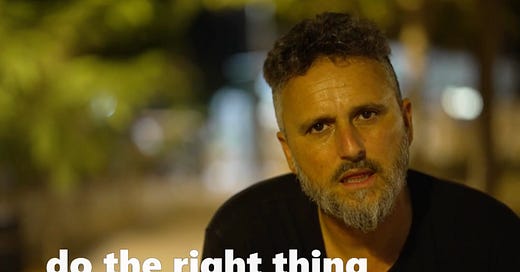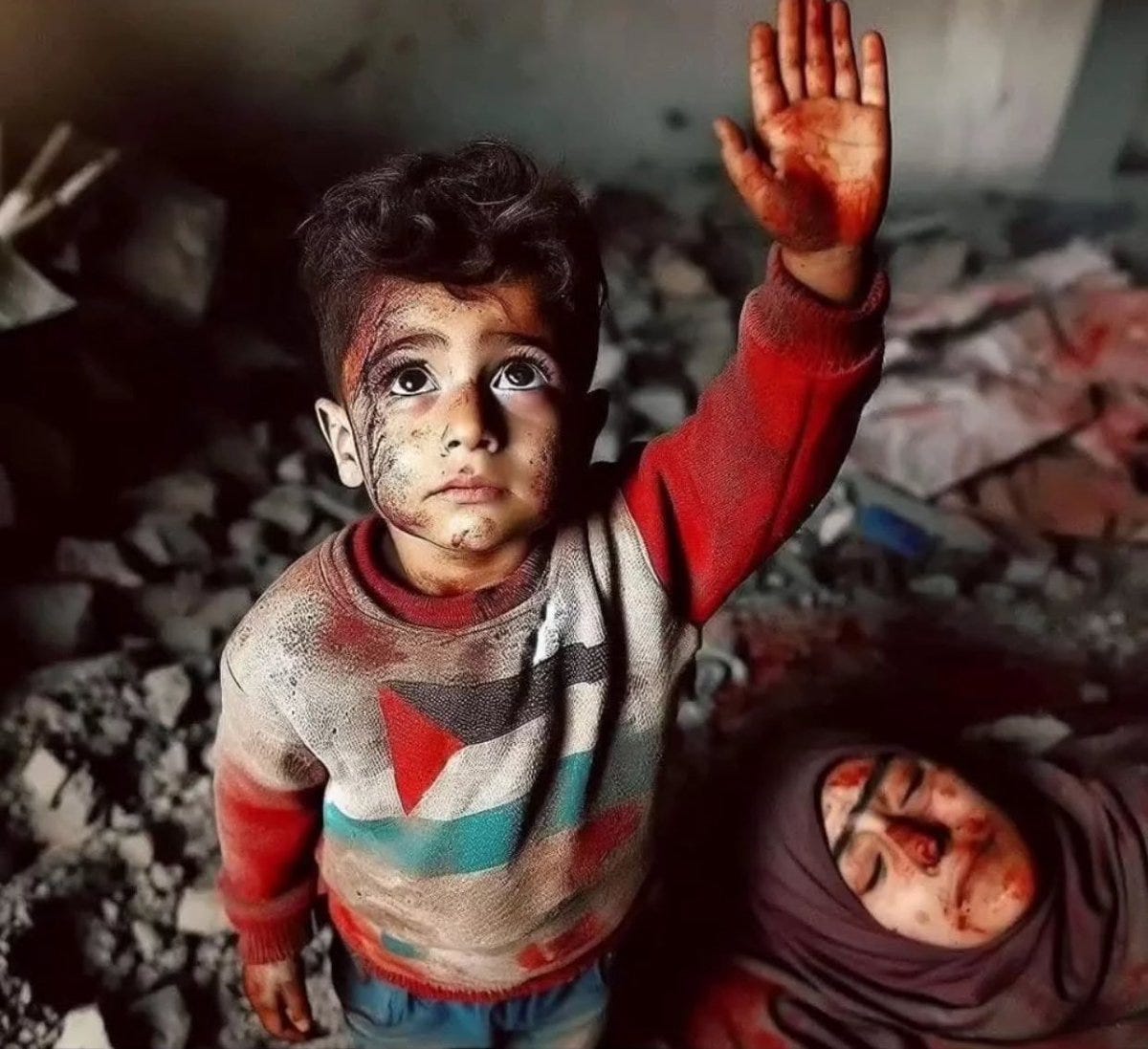There is no other option today for me than to start with Ran Harnevo’s video, it was temporarily deleted on ‘X’ for ‘copyright’ reasons and on YouTube it is somehow ‘age restricted’. But you can find it here and here.
Most of you will have seen how this Israeli tech entrepreneur has decided to come out and take the resignation of Web Summit’s CEO Paddy Cosgrave to address the war in clear moral terms. We discussed the Web Summit affair here a number of weeks ago, but with the actual event starting in Lisbon next week, Harnevo channeled his anger and frustration in what I think is one of the best videos made about the October 7 attacks and its consequences. It also gave me the topic for today: the media and the changing public opinion about the war.
The reason is that after a very short window of support for Israel, it seems that the sentiment is moving in a pro-Palestinian direction. The number of pro-Hamas rallies, the increase in anti-Semitic incidents, the diplomatic recalls and the endless recycling of alleged war crimes by the IDF in the media seem to point to a steady reduction in support for Israel. But is that what is really happening?
The Social Media Battle
Sifting through my Facebook and Twitter feeds I am getting a sense that the anti-Israel voices that came out strongly about a week after October 7 once the aerial attack on Gaza got underway, have become somewhat less vocal. It is not a terribly scientific method, but it appears some of these voices have become less frequent, more moderate or have gone quiet altogether. There are also voices that have surprised me and moved from an initially neutral to a decisively pro-Israel stance. But that may all be conjecture on my part. What do the experts say?
The Polls
Polls are not always terribly useful as they depend on how the questions are framed and asked. It also does not always help that in this case they are embedded in a ‘should we get involved militarily’ narrative which of course yields negative responses: the Iraq and Afghanistan traumas are definitely present. But from the ones out there it strikes me that they reveal a pattern that points to support for Israel. Consider this:
Respondents were asked “Do you approve or disapprove of the way Israel is responding to the October 7th Hamas terrorist attack?” Half approved and 35% disapproved overall. But only 32% of respondents aged 18-34 approved of Israel’s response, as opposed to about 58% of those aged 50 and older.
It raises some hard questions about how the young ones are looking at the war, but some 50% approving of Israel’s approach is considerable. If you take it out of the context of Israel’s military response, the actual support for the embattled nation remains strong:
Overall, 65% said the U.S. should support Israel publicly. That was true of big majorities of both parties — 77% of Republicans and 69% of Democrats.
These are US numbers; Canadians appear to be more divided on the issue but that may also be because the questions there were framed in terms of giving direct support to the war. It is hard to give definitive numbers for Europe, it is a mixed bag and you have to break it down by country. One extreme are the Irish who don’t particularly like Israel, however the Romanians clearly do. In the larger countries such a Germany, France and the UK there are deep divisions and shifting options often influenced by the larger Muslim populations each of these countries has. But it is quite safe to say that while the continent is divided, there is no pull away from support for Israel or a clear break to line up a majority behind the Palestinian side.
The Silence
So what is both deafening and concerning is not the endless noise and opinions, but the big silence. Just consider how many people, whether they are regular commentators or not, have gone quiet. Or think of the celebrities who are quick to come out when issues like climate or racism were headlining: many have now checked out altogether. Just look at Ran Harnevo’s video on Web Summit and it strikes me that while it plays very well in pro-Israel circles, the tech community at large is not terribly engaged with it, they prefer to stay on the sidelines and let the debate play itself out.
Being quiet and taking the sidelines is always an easy way out. The fear of burning bridges or losing business and friends runs deep. To be clear, I am not going after people that never comment, but there are just too many voices that are otherwise incredibly vocal and where are they now? Not a peep.
The Noise
What has ramped up is the incredible noise from the anti-Israel camp and it is using all the tools, in particular algorithms, available. According to the NYT it is nothing short of an online war actively supported by networks in China, Russia and Iran. Social media on steroids and with notable results. The levels of misinformation, media manipulation and social media attacks are not just trying to tilt the perception of the war and its rationale, they are actually fuelling real violence across many different locations, recall for instance the Dagestan airport pogrom.
Of course, none of this is new. My friend Richard Landes, a Jerusalem-based US historian, coined the term ‘Pallywood’ way back in the early 2000s which denotes staging events by Palestinians to manipulate western media. It was a problem back then, but now things are turbocharged by social media and consumed by a young generation that almost exclusively derives its news and opinions from these sources. So if you see a strong anti-Israel bias and even significant support for Hamas in the 18-34 year old bracket, then you know exactly how that has come about (with the help of our unmoored universities and schools). The noise is now driving the most obscene narratives and lies, luckily some are easily dismissed as for instance the Palestinian kid and his mother. His six fingers gave the thing away.
Peeling People Away
The newsletter here is not a political tool. It is to provide analysis and context and in some cases it needs to step up and drive the facts. In the face of the horrors of October 7 and the barrage of misinformation it is a moral duty to call out the nonsense. As we are seeing how certain media stories generate violence it is actually imperative we do that. But as in every political battle it comes down to getting the message out in a factual way such that people will not only trust your judgment, but also accept a narrative that they so far have been unable to evaluate and accept. That is very hard to do. It means peeling away the large and silent crowd from the pre-conceived notions and the self-reinforcing dynamics of in particular social media. Describing the horrific Hamas attack in all its gruesomeness is a necessary first step. Putting Israel’s response in that context is the next one. And then connecting the dots by bringing in history is the next one and Ran Harnevo’s video is a great example of doing just that.
As the news evolves we keep adding and analyzing in a way that brings us closer to the truth, hopefully turning the tide of public opinion. At the same time we are scoping out a way where reason, humanity and democracy can overcome the darkest human impulses. It is not easy, but is has got to be done.





It has been relatively quiet on m Facebook thread--I can think of two friends on each side of the issue adding support memes for their side. Granted my 400-ish friends have become pretty quiet about politics in general in the last year or two. With the Israeli situation I think most are a bit timid about showing how they actually feel. I haven't been shy about expressing support for Israel when the opportunity arises but neither am I posting memes about it.
Disclosure: My current influence is https://www.youtube.com/watch?v=m19F4IHTVGc that is an animated history lesson released prior top the current conflict. The lesson begins with the landed players in 1700 BC. I felt this history was evenly presented while also acknowledge that history is framed by the victorious. I'm curious about other views of this video animation. For example, who is the victorious publisher?
1) It seems that when the British withdrew the outcome was perceived to be a secure nation state for the desiring immigrants returning home. Today, this home seems to be a modern ghetto for the inhabitants that suits the needs of supporting other nations states supplying weapon systems to requiring the immigrants defend the borders of their modern ghetto. The immigrants after struggles in battle with the losses to all inhabitants, many non-combatants on opposing sides, created a ghettos by peace treaties within their modern ghetto nation state. I feel all current conflict immigrant non-combatants need to radically accept their role(s) in this process. Sadly, the immigrant non-combatants on both sides are suffering post traumatic stress disorder (PTSD) and that makes radical acceptance particularly difficult when it is further stirred up by opportunistic stakeholders aka the other others.
2) The young six fingered boy is perfect example of well placed propaganda. I believe he has 6 fingers. Maybe that's blood smeared on his hand. Maybe that's not his mother. Perform a search on Google Images with "what is genetic instance of 6 finger hand" aka Polydactyly genetic disorder. The six fingered boy now has PTSD too.
This is my 2 cents. Don't injure the messenger. I am still a faithful reader of Pieter's posts.